| Corcoran Technical Trading Patterns For April 28 |
| By Clive Corcoran |
Published
04/28/2010
|
Stocks
|
Unrated
|
|
|
|
Corcoran Technical Trading Patterns For April 28
Readers of my commentary yesterday may have detected a certain amount of exasperation in my comments on the relentless ascent of the S&P 500 and the apparent absence within the fund management community of any concerns about the fact that the second most traded currency in the world - in which trillions of euros of assets are denominated - could be fighting for its very survival.
As suggested, tools from TA - such as MACD, RSI and other indicators of dissonance - had been pointing to the fact that global equity markets have become unsustainably complacent and that the expectations for a correction were considered minimal.
The chart below tells you almost all you need to know about the way that this complacency was shaken severely yesterday. Notice how the VIX reached right to the top of the cloud formation - with a 30% jump - illustrating just how useful Ichimoku formations can be for money management and setting targets/stops.
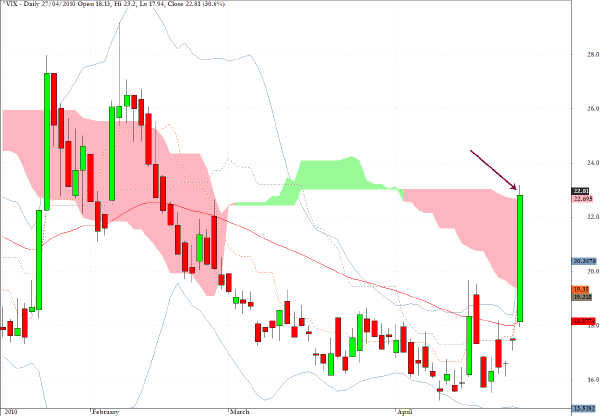
Here is my comment from yesterday on $EURUSD.
Once again the euro is under severe pressure in European trading and we appear headed for yet another test of the $1.3275 level.
According to one estimate from Goldman Sachs the cost for bailing out Greece could reach 150 billion euros which will not sit well with Angela Merkel’s coalition partners in Berlin.
If the currency breaks decisively below the previous support level around $1.3275 then the $1.30 level seems to be the next obvious target.
I did have a very profitable session yesterday but would have had even more satisfaction by benefiting from the wild movements in the sovereign CDS markets as rates on all Club Med countries surged. Portugal is now being lined up for the next attack - and the UK can only be thankful that it declined the opportunity to join the eurozone. As I intimated above - the currency union experiment lacks the architecture and heritage to deal with the problems of Greek government debt which now has junk status, and it is not a stretch of the imagination to contemplate that policy-makers in Berlin must be seriously looking at Germany exiting the EZ and re-establishing the D-mark before it all goes pear shaped.
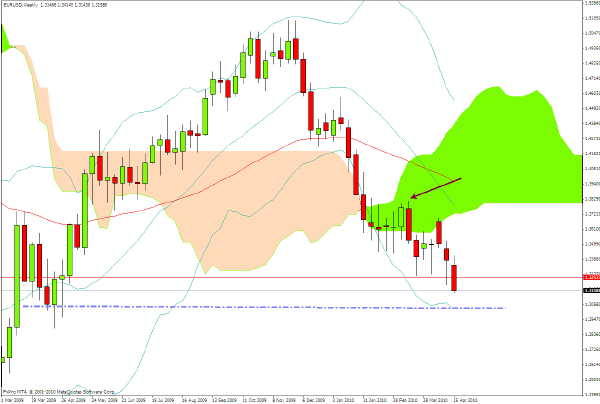
One of the great fascinations that the markets have for me is the manner in which risk appetite expands so that all kinds of exciting opportunities seem feasible, and then the events of the last 24 hours suddenly sees many fund managers scurrying back to the safety of US Treasuries, the dollar and chucking out the more adventurous securities that seemed such a good idea at the time.
The chart for the Brazilian index shows that this market dropped precipitously and has broken a clear uptrend line since February.
Using Ichimoku as a cue there would seem to be support at the base of the cloud and there could be quite a bounce, but the dynamics seem a lot less bullish than they were before the credit ratings agencies could no longer avoid the obvious conclusion that many sovereign credits need downgrading - with several in risk of moving below investment grade. This is not a small issue since in so doing Greek government "securities" (if that is not an oxymoron) can no longer be held by most mainstream fund managers and pose real problems for the ECB which has accepted them as collateral in repo agreements.
The ECB looks to be between a rock and a hard place over current developments and there is no mechanism - as in the US and UK - to provide them with easy ways to grab EU taxpayer money to bail out basket case economies - of which there are many within the enlarged EU.
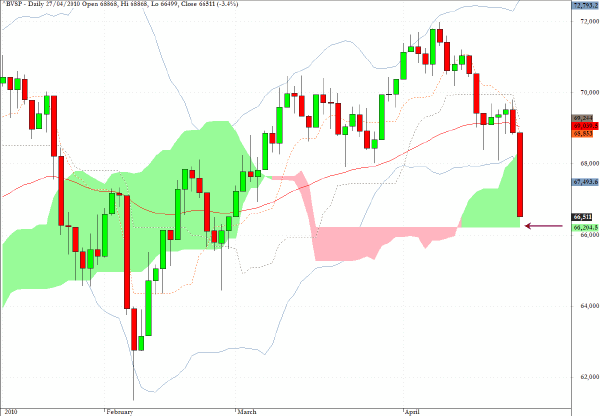
The CAC-40 in France plunged during the latter part of the trading day in Europe - not only in sympathy with most other European markets but additionally because its banks have the largest exposure to Greece.
I am not aware of any ETF which allows one to short the French market - perhaps readers may know of one and can let me know, but this is a territory where the woes of Club Med are going to be felt more severely than many others.
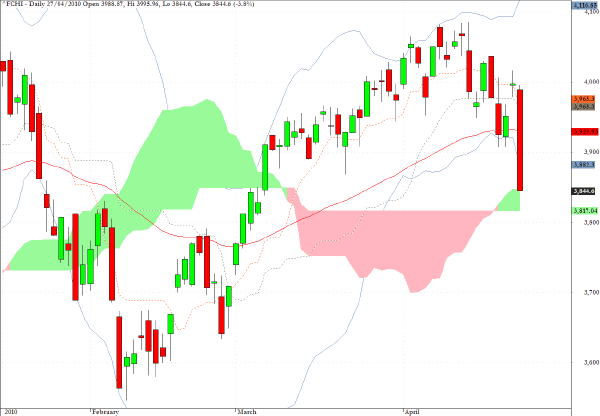
I thought it would be good to have a look at how many of the suggestions made here recently have performed.
BIK - a play on the BRIC economies - has revealed that the bear flag formation - especially following a heavy volume plunge - still acts as a reasonably reliable precursor of trouble ahead.
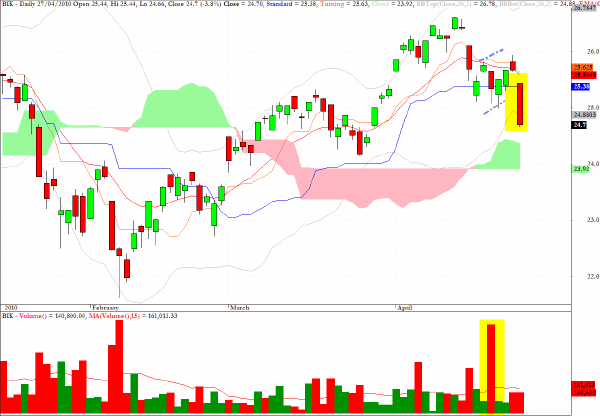
Here is a comment from Monday’s column
The sector fund for Australian equities, EWA, is on my list this week as a short candidate.
This market is especially vulnerable to further tightening in the Chinese economy - and the PBOC cannot be feeling too clever about their currency diversification strategies which have seen them switch away some of their US dollar holdings to having greater exposure to the euro. Let’s hope that they have bought credit protection on their holdings of southern European sovereign debt.
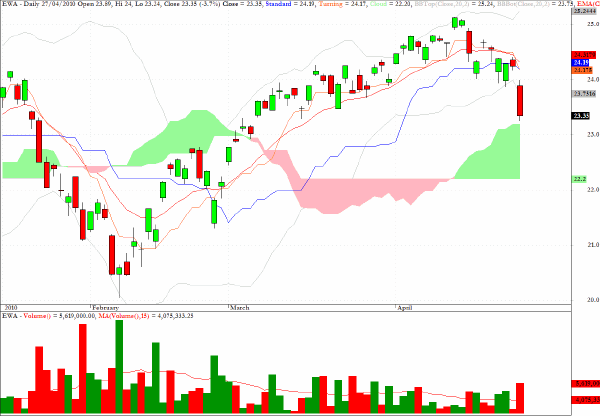
Also discussed here recently were the growing negative divergences for EZA which tracks South African equities.
The actual targets suggested have been realized and I have highlighted the last three sessions which is a textbook example of an evening star candlestick pattern.
Further downside is to be expected.
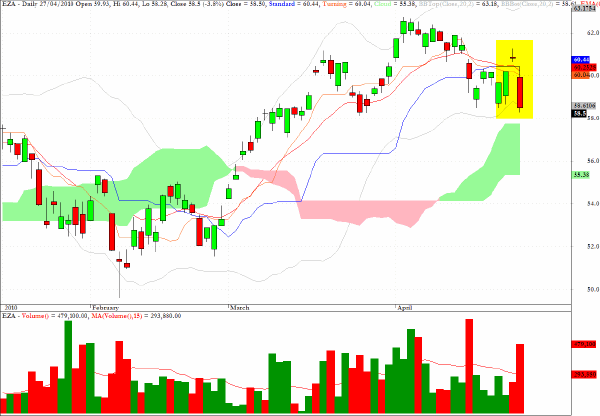
IAI was also a feature sector fund last week and again the bear flag formation is in evidence.
On a related matter the Senate/GS hearing provided fascinating television yesterday and showed that the company, which is undoubtedly staffed by some of the brightest people on the planet, just cannot help itself from being predatory.
The argument that Goldman always puts its customers’ interest first was made to look laughable by the evidence presented. Having said that I shall repeat something from my recent blog on the company.
For the so called "sophisticated investors" (a misnomer to be sure - but their hubris will promulgate that self delusion) who are the clients of Goldman, the intense focus that has now been brought to bear on the company will only underline and reinforce their conviction that it is best to be with the most ruthless predator in the shark infested eco-system known as Wall Street.
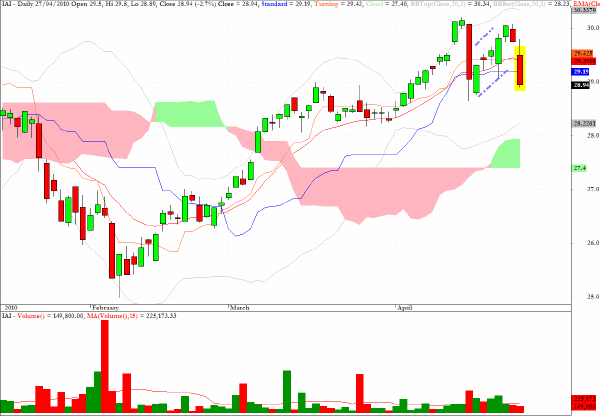
Sometimes it’s important to know when to step aside and readers may recall that I discussed the chart for yields on the US 10-year Treasury. I said that the Ichimoku charts were sending a confusing message and that it was a good time to stay on the sidelines - anticipating that there might be a flight-to-safety issue.
TBT, which moves in line with yields on the long end of the Treasury spectrum, shows that the advice to step aside was only partly right - it would have been better to have been short TBT or long the IEF fund - but at least going short Treasuries - which some highly respected analysts were claiming was the no-brainer trade of the year - was avoided.
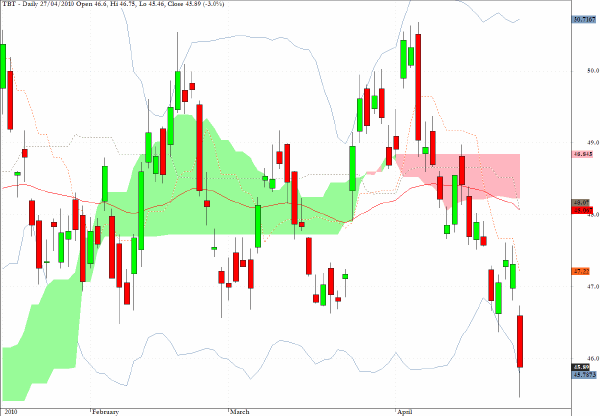
XLP dropped far more than XLY yesterday breaking key trend-line support and I have marked where this sector fund which represents consumer staples may be headed.
As part of a book which I am currently writing on inter-market technical analysis, I have examined the manner in which many patterns/correlations are breaking down in the new normal. XLP is usually considered to be a more defensive play than XLY - which is for consumer discretionary stocks - but the greater vulnerability of the staples now reflects the growing chasm between those who have had a good recession - the professional classes who have plenty of discretionary income - and those who have lost homes, jobs and are no longer buying branded staples but generics and at a reduced level.
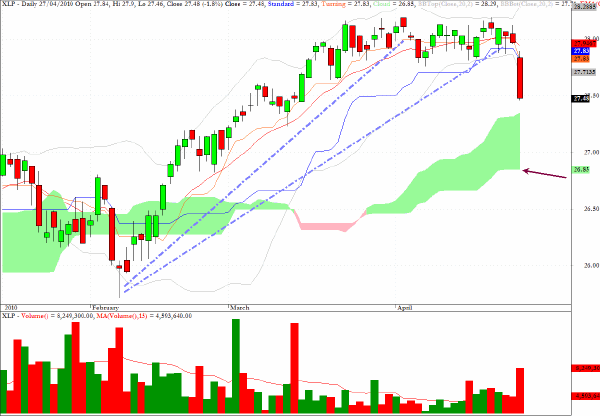
Clive Corcoran is the publisher of TradeWithForm.com, which provides daily analysis and commentary on the US stock market.
|